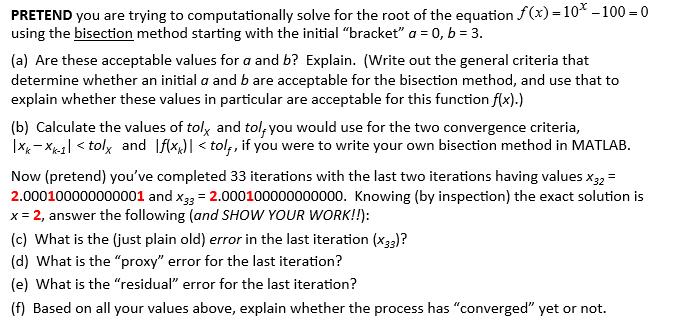Answered step by step
Verified Expert Solution
Question
1 Approved Answer
PRETEND you are trying to computationally solve for the root of the equation f(x) = 10* -100 = 0 using the bisection method starting

PRETEND you are trying to computationally solve for the root of the equation f(x) = 10* -100 = 0 using the bisection method starting with the initial "bracket" a = 0, b = 3. (a) Are these acceptable values for a and b? Explain. (Write out the general criteria that determine whether an initial a and b are acceptable for the bisection method, and use that to explain whether these values in particular are acceptable for this function f(x).) (b) Calculate the values of toly and tol, you would use for the two convergence criteria, |X- X1| < tolx and If(x,)| < tol,, if you were to write your own bisection method in MATLAB. Now (pretend) you've completed 33 iterations with the last two iterations having values x32 = 2.000100000000001 and x33 = 2.000100000000000. Knowing (by inspection) the exact solution is x = 2, answer the following (and SHOW YOUR WORK!): (c) What is the (just plain old) error in the last iteration (x3)? (d) What is the "proxy" error for the last iteration? (e) What is the "residual" error for the last iteration? (f) Based on all your values above, explain whether the process has "converged" yet or not.
Step by Step Solution
★★★★★
3.36 Rating (162 Votes )
There are 3 Steps involved in it
Step: 1
a Given f x 10 100 fa f0 10 100 1 100 99 fb f3 103 100 1000 100 ...
Get Instant Access to Expert-Tailored Solutions
See step-by-step solutions with expert insights and AI powered tools for academic success
Step: 2

Step: 3

Ace Your Homework with AI
Get the answers you need in no time with our AI-driven, step-by-step assistance
Get Started


